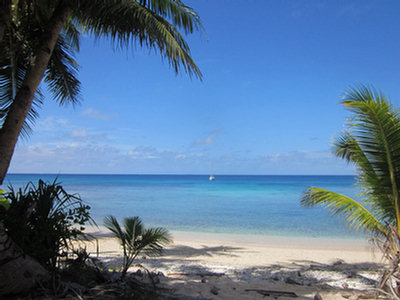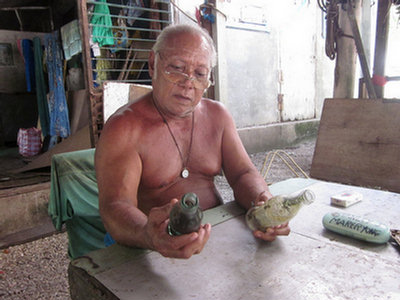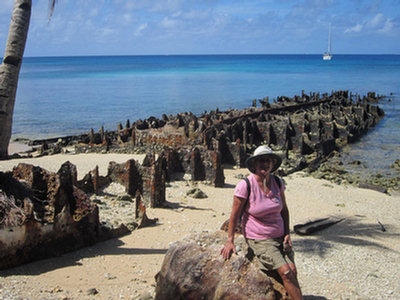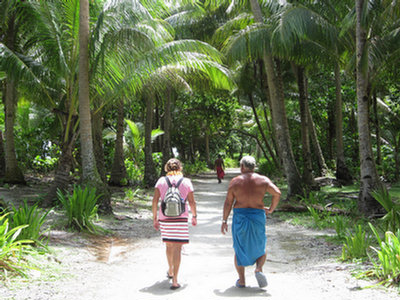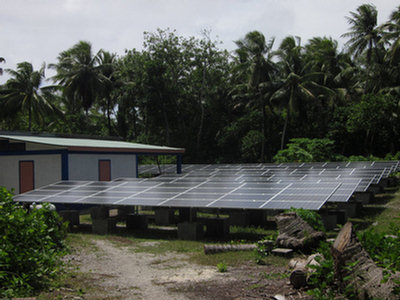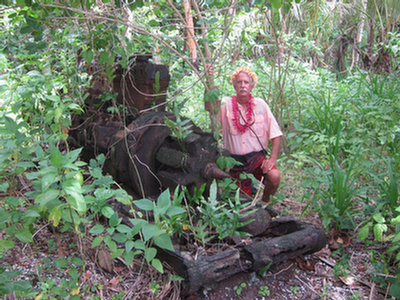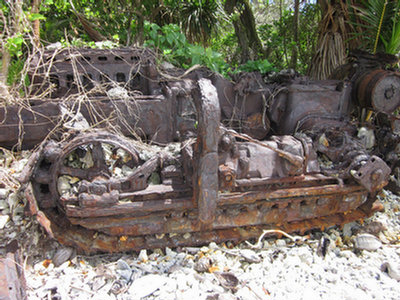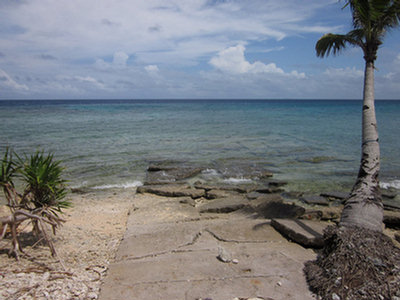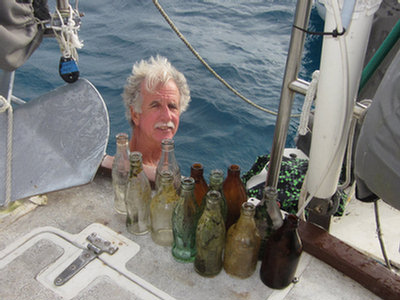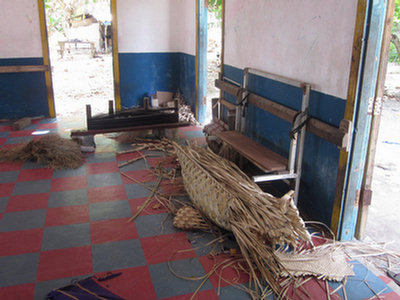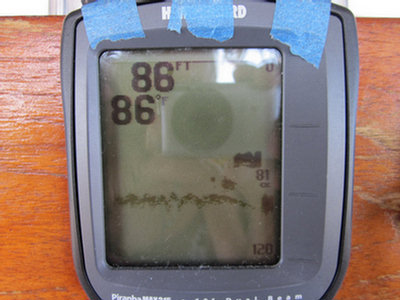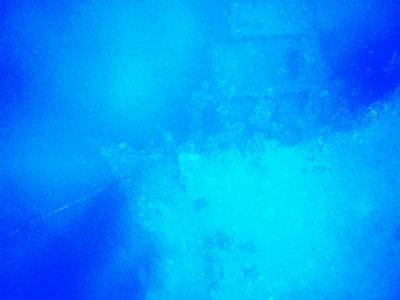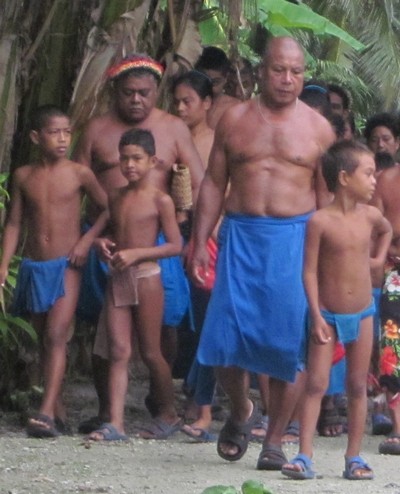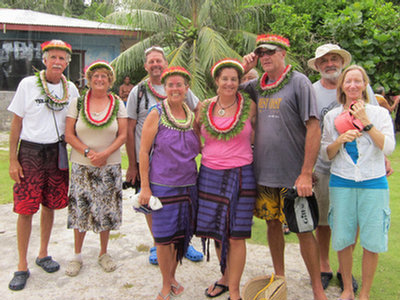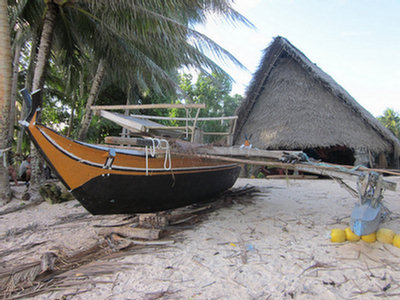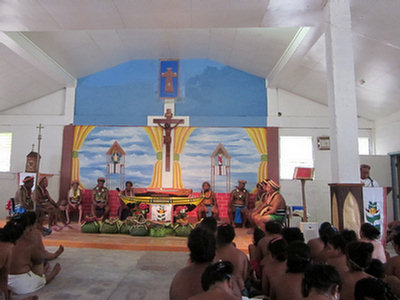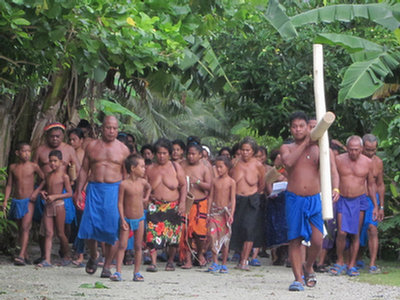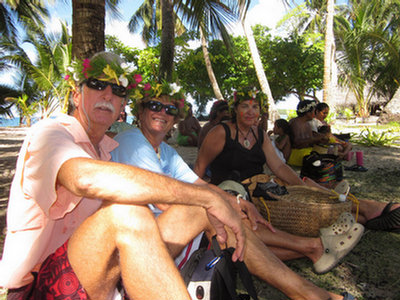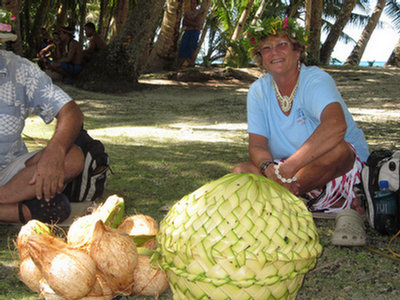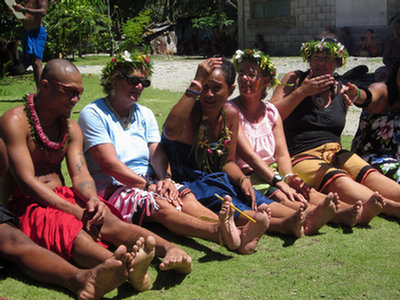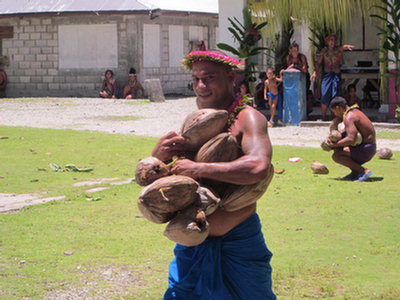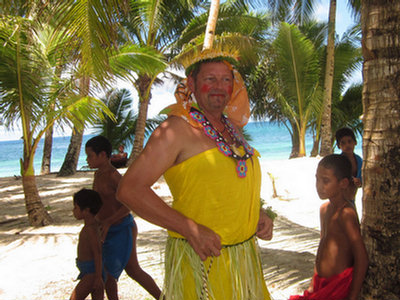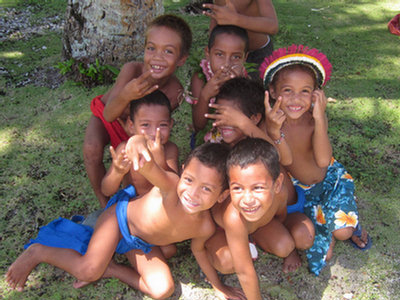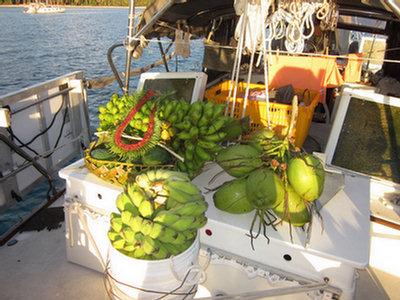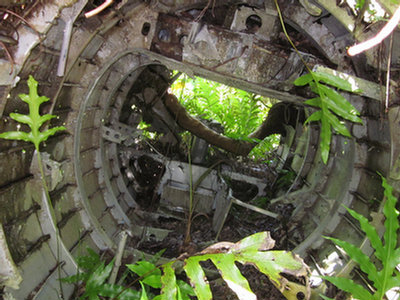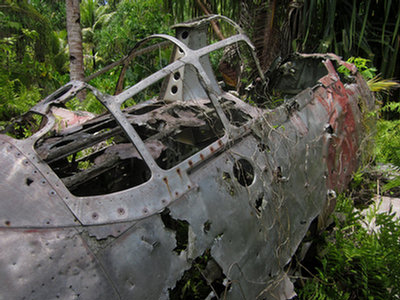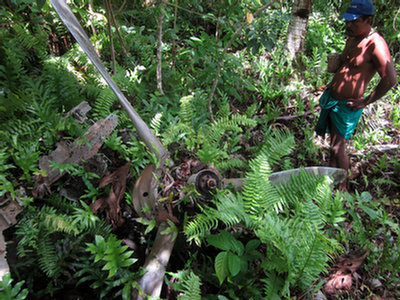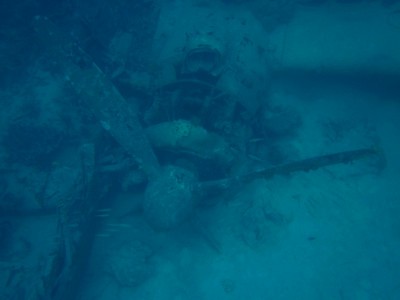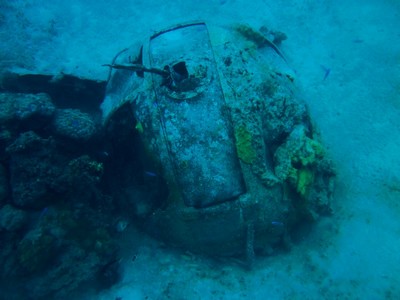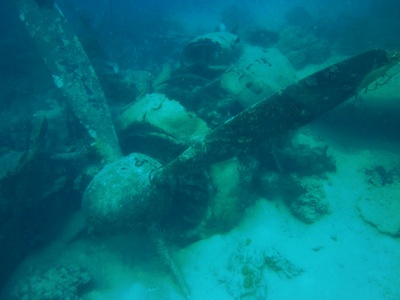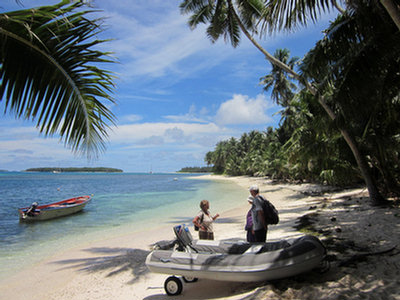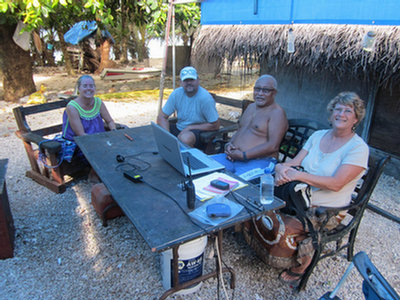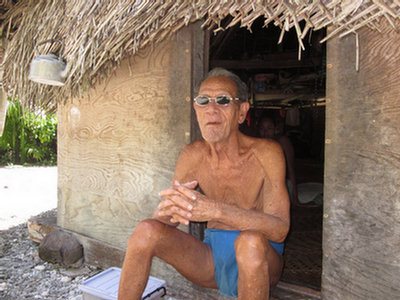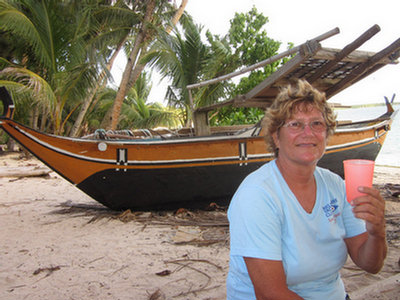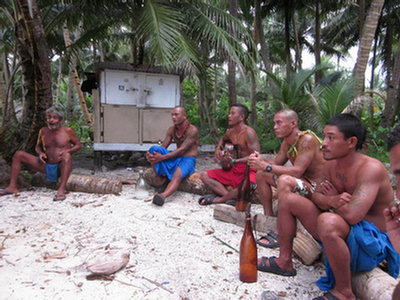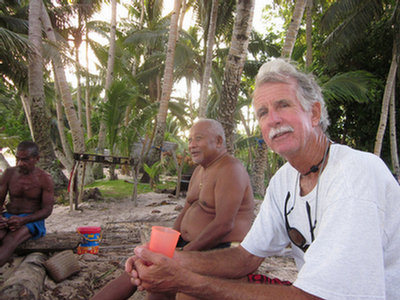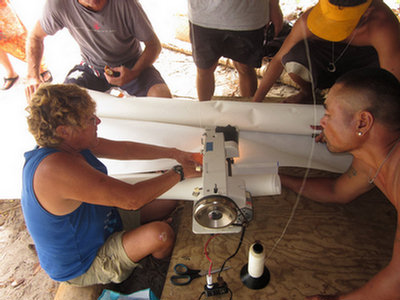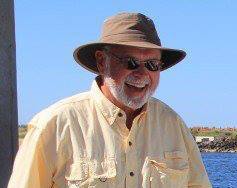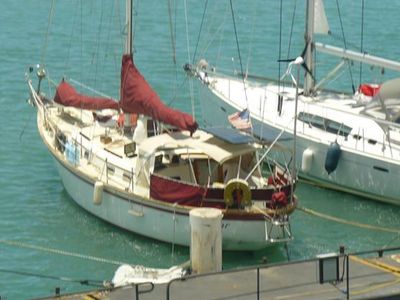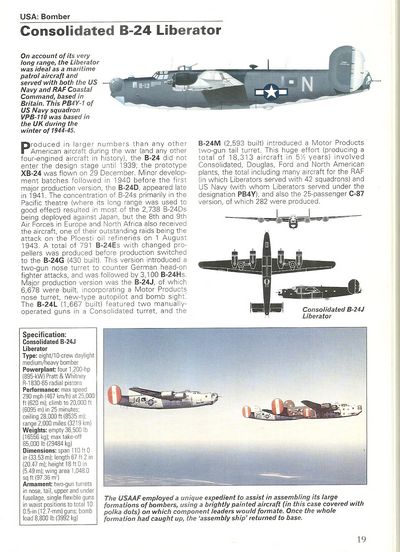At no time in the nearly 2 weeks we were in Chuuk did we feel threatened. We DID NOT get harassed, shot at, accosted, nor did we have rocks thrown at us. People we met were in general very friendly and helpful, and interested in us. They hardly get any cruisers through Chuuk, so the people we met on the street assumed we were working there or diving there.
We DID abide advice from other cruisers and locals about where and where not to go. (Do: Truk Stop and Blue Lagoon anchorages. Don't: Anywhere else and especially not in the Tol area). And we made sure we were pretty much theft-proofed on board (same as we would cruising most of the Eastern Caribbean and Central America).
Some useful waypoints and information for cruisers following behind us:
SE Pass we used: 07-12.00N / 151-59.74E Outside
07-13.54N / 151-59.47E Inside
This is basically a on direct line from the Mortlocks (Lekinioch/Satawan) to Chuuk. Visibility entering at 8am was fine, and all the hazards in the lagoon matched our CM93 (2010) chart and Google Earth chart reasonably well. From there we went north around Dublon/Tonowas and up the west side of Moen/Weno.
Truk Stop Moorings: 07-26.52N / 151-50.25E
Our Best Anchorage: 07-26.51N / 151-50.205E
The moorings would be preferred, but there are 2 semi-permanent boats there right now. Their moorings are 3/8" chain around coral heads, and they have the best anchoring spots. Where we anchored was as close as we could get with 360-degree swing. We dropped in sand, but ended up hanging over some coral, so we bouyed our anchor chain with buoys at 90' and 125'. Depending on the wind, we ended up in the middle of the "morning rush hour" small boat traffic lanes. Make sure you have a bright anchor light at all times. To get closer in, out of the traffic, there's not enough swinging room.
Dinghy dock is the Truk Stop pier, where we were welcomed, as long as we didn't get in the way of the dive boats. They also didn't mind if we dumped our trash in their bins. Fuel if you need it in small quantities is by jugging. Large quantities of fuel or water could be had by arrangement at the commercial pier. Gasoline was $5.25 per gallon at the gas station.
Commercial Pier: 07-26.69N / 151-50.39E
This is a large/high concrete pier with big black rubber fenders to keep you off the concrete. It is nicely protected from all directions except west. You will need long lines to tie up here, as the bollards are high and widely spaced. There are usually dock workers loitering about to take your lines (you will need someone on shore to get tied up).
Getting on and off the boat at the pier is a problem--a scramble up the high sides of the pier. Almost all the officials opted to deal with us from up on the dock vs coming aboard. One, the Immigration guy on check-out, wanted to come aboard and take a look around. We weren't sure whether he was looking for stow-aways, or just curious. He was nice and friendly and was more interested in our lifestyle than anything else.
There is no one to contact before going in--NO ONE uses VHF in Chuuk (not the officials, not the dive operations or the dive boats). If there's space at the dock, feel free to tie up. Depth to about 25-30 feet, so no problems for sailboats. If there's no space on the south face, you might be able to raft to someone for clearing in, or use the west face of the dock, or anchor close off the west face until you can arrange to come alongside (mandatory we are told for clearing in). The large ships that come in, do dock on the west face, but they only come in for a few hours once every 2 weeks. The dock workers will know if there is a ship coming in soon. Most of the time there was plenty of space at the pier for a sailboat.
There is a 24 hour guard on the dock, so we felt pretty secure, but we still were at Code Yellow status (everything loose on deck stowed below, and the boat locked up when we left). We had no troubles whatsoever anywhere in Chuuk, and had we not been warned about all the possible bad stuff beforehand, we'd have found Chuuk very friendly.
Blue Lagoon Anchorage: 07-24.86N / 151-50.47E
This is nestled up in a sand spot as close in as we could get, with decent protection from NW through E and almost to S. In about 25' sand. We bouyed the anchor with 2 sets of bouys to minimize any coral damage (this is within snorkeling distance of the Blue Lagoon Resort). We went ashore at night, leaving our dinghy on the beach, and had dinner. There is a security guy roaming the grounds.
Blue Lagoon Odyssey Mooring: 07-24.8N / 151-50.4E
This is the mooring for the Odyssey live-aboard dive boat. It is normally vacant except for Saturday and Sunday evenings, when they do the guest change-over. You can probably use it with permission. But we could not raise Odyssey on VHF, even when we came in and anchored very close next to them. There is reportedly another mooring for Odyssey on the east side of the Blue Lagoon peninsula, but we don't know the exact location.
When we asked where we should go if the winds went west, someone told us "on the other side of the airport". Good Google Earth charts of the north and east side of Weno/Moen would be recommended if you're staying long in Chuuk. We did not do any exploring over there, but a day trip on a calm day exploring would be worthwhile, to suss out a spot for a westerly blow.
NW Pass we used on Exit: 07-26.21N / 151-33.05E
This is a wide-open pass with easy exit. The route direct from the Commercial Pier to this pass is fairly easy. Our CM93 (2010) chart showed 2 or 3 small shallow spots, which (on close inspection) we also found on the Google Earth chart. But this pass is 17 miles from the pier/Truk Stop, so you need to get an early start so you're not navigating with the sun in your eyes. There are two or 3 passes to the north of this one that are closer (closest is about 13 miles, and more to the NW so you wouldn't be absolutely into the sun in the afternoon).
Checking out: We started by making sure we had the phone numbers of all the officials we needed to see on checkout when we checked in. (they are listed in our Micronesia Compendium) Then a day ahead of time, call them and set your departure time and make a firm appointment for them to come visit. Understand that the airplane schedule will affect when they visit. Currently, on Sunday night, there is a 3am flight (they will be less responsive in general on Monday because of this). On M-W-Fr, the regular flight is in the morning. On T-Thu-Sat, the regular flight is in the afternoon.
Because we wanted to leave first thing Tuesday morning, we set up for a Monday afternoon checkout, and planned to pay for an extra night and stay at the concrete dock overnight. They said they normally didn't allow checking out a day in advance, but they allowed us to do it. (Dave was so nice and courteous to everyone, I think it helps).
Once we got into the dock, it turned out that Monday was a holiday, and we paid overtime anyway to Immigration and Customs--double on Holidays, a total of $75. But this was our fault, and once informed by the Immig guy, we could have opted to wait til the next day and not pay any overtime (March 31 was "Cultural Day"). If we'd waited til Tues am, we would have only had to pay the port charges ($130 total, itemized, with a receipt, no overtime included).
The only official we had trouble with was again the Port Captain. Never got an answer on his cell phone. I think he never has it on or doesn't carry it. He told us a text message would have been better, because it's there when he turns his cell phone on. He also said he passes the port a couple of times a day, and will see any boats that are there. Once we got him at the boat, he was friendly and efficient. He went away to prepare the "port clearance" paperwork and came back an hour later with that and the "port charges" bill.
Again, everyone was polite and friendly. I think each official wanted another copy of the crew list, even though it was the same one we gave them on clearing in. I had also made several copies of our Cruising Permit in anticipation, but I don't think anyone asked for it.
We dinghied over to Truk Stop for a last meal, and loaded the dinghy that night, and left about 7am Tuesday morning.
Some helpful people--Mason Fritz--associated with Truk Stop (cell 930-6424). Speaks good English, related to several of the officials, and generally very interested in seeing that visiting yachts have a good experience. Also, a guy by the name of Gideon, who is the head/manager of the stevedores at the port. Speaks good English, and knows the workings of the port well. (cell 932-2644). Gideon has family on Puluwat, so if you are going there after Chuuk, you can thank him by carrying a few items for his family (we took a cardboard box, 50lbs of rice and 20 lbs of "turkey tails" to his sister).
Provisioning: There is an ATM (Bank of FSM) and a grocery store across from Truk Stop. Fair supply of goods. About a block down towards the airport (next to the Yamaha place and just across from the port) is another store with better (and more expensive) stuff. I think it is called Shigato. They had a good supply of veggies after the ship came in. There are two ships. The blue "Hibiscus" ship doesn't carry veggies. The other ship that comes in 3-4 days after Hibiscus has the good veggies, according to the owner of Shigato. Hibiscus is the same ship that stops in Majuro and Kwaj and Pohnpei, so if you figure out the schedule (every 2 weeks) in one of those places, you can have an idea when the ships are due in to Chuuk. Hibiscus came in on a Sunday, and the other ship on Weds. By 10 days after the ship came in, we had trouble finding any veggies that weren't essentially dead. Between Truk Stop and Shigato, there's a Bank of Guam. There's also a lady who sometimes has local vegs for sale (bananas and papayas).
WARNING: We were warned several times NOT to stop at Tol... This is the big set of islands near the far western end of the atoll. These people have a bad reputation as being a bit lawless. It is also pretty reefy getting through there. This is where C'est La Vie ran into trouble. It would be tempting to stop there coming in from the west late in the day, but not recommended. Better to come in the south pass and stop overnight behind Uman, if you have to.
Stopping ANYWHERE but the Commercial Pier, Truk Stop, or Blue Lagoon, and you are likely to be asked for a fee to stay. This is the Chuukese way, and applies to everyone, not just foreign vessels (unless you are part of the clan or connected by friends/family).
This info will all be incorporated into our Micronesia Compendium on
svsoggypaws.com when we next have internet, so if you have a later version than A.7, you will have all this info in the Chuuk section already.


